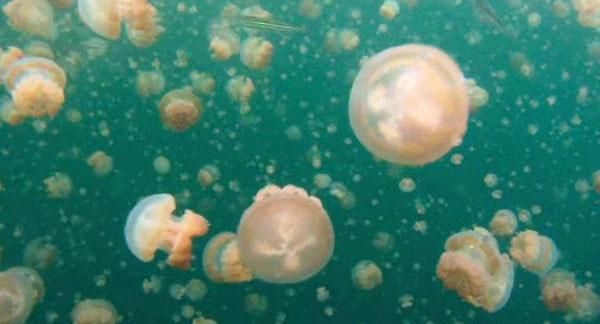
Diver Makes Amazing Video in Rare Jellyfish Lake

Jellyfish are familiar to many beachgoers who step around them as they wash up on shore to avoid a nasty sting. But on one western Pacific island there's a saltwater lake where divers voluntarily go swimming with the local jellyfish, and one diver caught the experience on video.
Pat Lohmann, an emeritus researcher at the Woods Hole Oceanographic Institution in Massachusetts, was on the tiny island nation of Palau to study the coral reefs surrounding it . The visit to the lake, aptly named Jellyfish Lake, came at the end of the first day of their efforts.
"Jellyfish Lake was just a fun dive after a full day on the water," Lohmann said.
Migrating jellyfish
Lohmann took an HD camera into the water with him to record the experience and the jellyfish as they swam around. [See his video here.]
The main genus of jellyfish in the lake is called Mastigias They are descendents of jellyfish from the ocean that are thought to have ended up in the lake when sea levels were much once higher, extending over the island and filling up the saltwater lake.
Like most jellyfish, Mastigias feed by stinging plankton with their tentacles to disable the tiny animals and capture them. But Mastigias' sting lacks the oomph of other jellyfish species, a good thing for the divers that swim there.
Sign up for the Live Science daily newsletter now
Get the world’s most fascinating discoveries delivered straight to your inbox.
Lohmann told OurAmazingPlanet the swarm of jellyfish around him did sting him, "but very mild, face and arms, everything else was covered with a wet suit. I've had much worse."
Because their sting doesn't carry the power of other species, Mastigias have also evolved another way of feeding they have a symbiotic relationship with algae that live in their tissues that use photosynthesis. This process uses sunlight and carbon dioxide to produce carbohydrates that the jellyfish use as fuel.
Because they need to expose their algae helpers to plenty of sunlight, the jellyfish migrate from one side of the lake to the other during the day, moving with the sun.
At night, the jellyfish stop their migration and move up and down in the middle of the lake, avoiding the edges where the sea anemones that prey on them live.
{brightcove CMS_LS_14459}
Difficult film set
Lohmann had little chance to observe the swarm of jellyfish around him while he was in the water, as he was too busy making sure his camera was working and getting usable footage. The camera wasn't intended to be used for such an endeavor, and the pouring rain made lighting a big issue.
"There's no viewfinder so I couldn't frame or compose the shots," Lohmann said. "I just tried to get as many different lighting and background combinations as possible."
Still, Lohmann has enjoyed the fruits of his labor.
"I actually got much more from watching the video of the jellyfish afterward at home than I did swimming with them at the time," he said.
But Lohmann has a better idea for filming any possible return trips: "If and when I return, I'll try to shoot in the sun with better optics and in 3-D. 3-D could be very cool."

Andrea Thompson is an associate editor at Scientific American, where she covers sustainability, energy and the environment. Prior to that, she was a senior writer covering climate science at Climate Central and a reporter and editor at Live Science, where she primarily covered Earth science and the environment. She holds a graduate degree in science health and environmental reporting from New York University, as well as a bachelor of science and and masters of science in atmospheric chemistry from the Georgia Institute of Technology.










